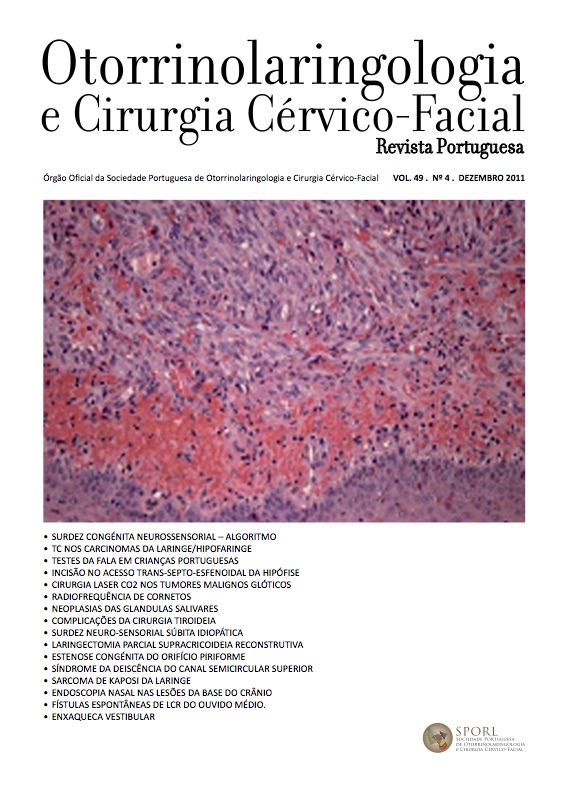Sublabial versus columellar incision in trans-septal transsphenoidal approach for microscopic pituitary surgery. Retrospective study.
DOI:
https://doi.org/10.34631/sporl.192Keywords:
Transsphenoidal surgery, pituitary surgery, complications in pituitary surgery, pituitary adenomaAbstract
Objectives: To compare the sublabial incision with the columellar incision in trans-septal transsphenoidal approach of microscopic pituitary surgery, concerning per-operative complications and observed sequelae.
Study Design: Retrospective study.
Material and methods: Revision of the clinical records of 50 patients submitted to transsphenoidal microscopic surgery to resection of pituitary adenoma, in Braga Hospital, between July 2007 and November 2010. Demographic data, pre-operative co-morbidities, histological and radiological classifications, operative time, lenght of hospital stay and per(pre)- and postoperative complications were collected and evaluated. Patient follow-up was one to six months. SPSS® Statistics 17.0 program was used for statistical analysis.
Results: 50 patients, 32 (64%) female and 18 (36%) male, ranging from 16 and 87 years old, mean 50 years old. 40 (80%) presented macroadenoma and 10 (20%) microadenoma. 15/47 (31.9%) patients were submitted to transseptal transsphenoidal surgery with columellar incision and 32/47 (68.1%) with sublabial incision. Oronasal complications were observed in 5/14 (35.7%) patients of the columellar group and 14/29 (48.3%) patients of the sublabial group (p>0.05). Overweight patients had more complications (p<0.01). There were no statistical differences in rates of patients with complications and age, sex, surgical incision, adenoma classification or other pre-operative co-morbidities. Operative time and postoperative hospital stay had no statistical differences in both sublabial and columellar groups.
Conclusions: In this study, sublabial and columellar incisions showed no difference in the per(pre)- and postoperative complications rates.
Downloads
References
Petry C, Leães CS, Pereira-Lima JS, Gerhardt KD, Sant GD, et al. Complicações oronasais em pacientes pós-abordagem hipofisária via trans-esfenoidal. Braz J Otorhinolaryngol. 2009;75(3):345-9. 5 autores
Santos AL, Neto RF, Veiga JE, Viana J, et al. Endoscopic endonasal transsphenoidal approach for pituitary adenomas: Technical aspects and report of casuistic. Arq neuropsiquiatr. 2010;68(4):608-12.
Ciric I, Ragin A, Baumgartner C, Pierce D. Complications of transsphenoidal surgery: Results of a national survey, review of
literature, and personal experience. Neurosurgery 1997;40(2):225-36.
Monnier DS. Séquelles endonasales après hypophysectomie. Ann Otolaryngol Chir Cervicofac. 1998;115:49-53.
Dew LA, Haller JR, Major S. Trans-nasal transsphenoidal hypophisectomy: choice of approach for the otolaryngologist. Otolaryngol Head Neck Surg. 1999;120(6):824-7.
Gammert C. Rhinosurgical experience with the trans-septaltranssphenoidal hypophysectomy: Technique and long-term results. The Laryngoscope 1990;100(3):286-289.
Kim SH, Yoon JH, Choi JU, Chung SS, et al. Transcolumellar approach in transsphenoidal pituitary surgery for patients with small nostril. Otolaryngol Head Neck Surg. 2001;125(6):609-12.
Gendeh BS, Sakina MS, Selladurai BM, Jegan T, et al. The transcolumellar transsphenoidal approach to pituitary tumours:
advantages and limitations. Med J Malaysia 2006;61(3):349-54.






